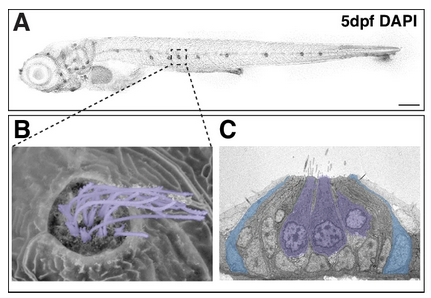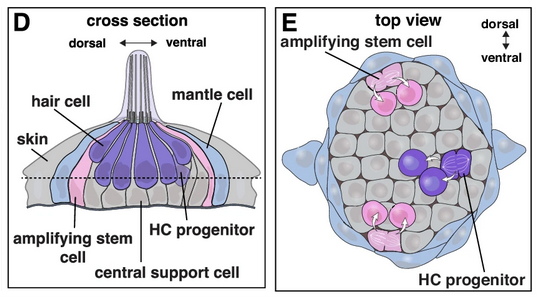Zebrafish are an excellent system for studying regeneration. Dotted in a straight line from their head to tailfin are sensory organs called neuromasts. Each neuromast resembles a garlic bulb with hair cells sprouting from its top. A variety of supporting cells encompass the neuromast to give rise to new hair cells. These sensory cells, which help zebrafish detect water motion, closely resemble those in the human inner ear that detect sound.
Now, the Hearing Restoration Project’s Tatjana Piotrowksi, Ph.D., and team have identified how two distinct genes guide the regeneration of sensory cells in zebrafish. The discovery improves our understanding of how regeneration works in zebrafish and may guide future studies on hearing loss and regenerative medicine in mammals.
Images: Microscope images of the zebrafish sensory organ that is similar to human inner ear structures: (A) location, (B) surface view, (C) cross-section, and (D, E) illustrations. Credit: Lush et al./Nature Communications
Subong Kim, Ph.D., a 2022–23 Emerging Research Grants (ERG) scientist, found a measurable brainstem difference between those who benefit from noise reduction hearing aid technology compared with those who do not. Kim also examined why two people with the same audiogram results hear so differently in noise.
2024–25 ERG scientist Nicole T. Jiam, M.D., shares highlights on her team’s push for personalized cochlear implant programming using music perception as a benchmark for spectral resolution. Jiam is the recipient of an Elizabeth M. Keithley, Ph.D. Early Stage Investigator Award, generously supported in part by Susan and Steve Kaufman.
Plus:
From Our Partners and Friends:
Around the Web:
The best noise-canceling headphones and the best earplugs for concerts (Wirecutter), do noise-canceling headphones help or hurt hearing? (University of Colorado), how to hear your TV better (Consumer Reports), and a review of 6 hearing aids that use AI and machine learning (Hearing Tracker)
A new comprehensive definition of noise (Proceedings of Meetings on Acoustics), a world built on fossil fuels is loud (The Grist), and how noise sensitivity disrupts the mind, brain, and body (BBC)
More than half of young adults report hearing problems from loud music (RNID), hearing loss lowers prospects of employment and higher income for young Americans (Frontiers), and doing this one thing at a concert can save your hearing (The Healthy)
Hearing loss and loneliness pave way for dementia and linking cognition and hearing is not a scare tactic (The Hearing Review), what should audiologists tell their clients about hearing aids and reducing dementia risk? (Canadian Audiologist), and why it’s important to protect your hearing as you age (The Guardian)
A single dose of AC102 reverts tinnitus in the gerbil model (International Journal of Molecular Science), patients with tinnitus and their perspective on sound generators (Noise & Health), and is there finally a way to measure tinnitus? (Harvard Health)
Novel approaches to protect the inner ear from drug-induced hearing loss (Caltech) plus new research sheds light on the mechanics behind sound sensitivity and how one tiny change in the ear’s wiring may set the stage for hearing decline (Hearing Health & Technology Matters)
Products and services are not endorsed by Hearing Health Foundation. Links provided are for informational purposes only and may require registration or subscription. Links to time-sensitive events may expire.




